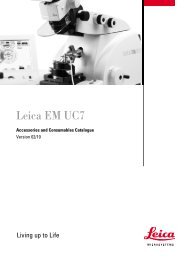Physical Principles of Electron Microscopy: An Introduction to TEM ...
Physical Principles of Electron Microscopy: An Introduction to TEM ...
Physical Principles of Electron Microscopy: An Introduction to TEM ...
You also want an ePaper? Increase the reach of your titles
YUMPU automatically turns print PDFs into web optimized ePapers that Google loves.
66 Chapter 3<br />
�<br />
r<br />
r<br />
s<br />
r<br />
�<br />
(a) (b) (c)<br />
r<br />
r<br />
area A<br />
Figure 3-5. (a) Two-dimensional diagram defining angle � in radians. (b) Three-dimensional<br />
diagram defining solid angle � in steradians. (c) Cross-section through (b) showing the<br />
relationship between solid angle � and the corresponding half-angle � <strong>of</strong> the cone.<br />
Because image broadening due <strong>to</strong> spherical aberration <strong>of</strong> an electron lens<br />
increases as � 3 , the ability <strong>of</strong> a demagnifying lens <strong>to</strong> create a high current<br />
density within a small-diameter probe is helped by keeping � small and<br />
therefore by using an electron source <strong>of</strong> high brightness. In the scanning<br />
electron microscope, for example, we can achieve better spatial resolution by<br />
using a Schottky or field-emission source, whose brightness is considerably<br />
above that <strong>of</strong> a thermionic source (see Table 3-1).<br />
Equation (3.3) can also be used <strong>to</strong> define an electron-optical brightness �<br />
at any plane in an electron-optical system where the beam diameter is d and<br />
the convergence semi-angle is �. This concept is particularly useful because<br />
� retains the same value at each image plane, known as the principle <strong>of</strong><br />
brightness conservation. In other words,<br />
� = Je/� = I [�(d/2) 2 ] -1 (�� 2 ) -1 = source brightness = constant (3.4)<br />
Note that Eq. (3.4) is equivalent <strong>to</strong> saying that the product �d is the same at<br />
each plane. Brightness conservation remains valid when the system contains<br />
a diaphragm that absorbs some <strong>of</strong> the electrons. Although the beam current I<br />
is reduced at the aperture, the solid angle <strong>of</strong> the beam is reduced in the same<br />
proportion.<br />
The last row <strong>of</strong> Table 3-1 contains typical values <strong>of</strong> the energy spread �E<br />
for the different types <strong>of</strong> electron gun: the variation in kinetic energy <strong>of</strong> the<br />
emitted electrons. In the case <strong>of</strong> thermionic and Schottky sources, this<br />
energy spread is a reflection <strong>of</strong> the statistical variations in thermal energy <strong>of</strong><br />
electrons within the cathode, which depends on the cathode temperature T.<br />
In the case <strong>of</strong> a field-emission source, it is due <strong>to</strong> the fact that some electrons<br />
are emitted from energy levels (within the tip) that are below the Fermi<br />
level. In both cases, �E increases with emission current Ie (known as the<br />
�<br />
r<br />
�<br />
r<br />
s



